石墨烯等离激元时间晶体中的慢光
2022-09-07卓立强庄凤江苏少坚林志立邱伟彬
何 真,卓立强,李 志,庄凤江,苏少坚,林志立,邱伟彬
(华侨大学 信息科学与工程学院, 福建 厦门 361021)
1 Introduction
The slow light technology has attracted more and more attention due to its quite broad potential application prospect in optical field regulation and optical storage devices[1-3]. Controlling the structure dispersion to realize slow light is one of the commonly used technologies at present. The main method of this technology is to control the light group velocity by designing a slow optical waveguide with a specific structure. Slow light generated in such photonic crystal waveguides has been observed in several studies[4-5]. However, in the previous slow optical waveguide structure, when the group velocity becomes slow, its supported bandwidth is very narrow, and it is also accompanied by a huge group velocity dispersion effect. Scheuer J.et al. used a complex coupled resonant optical waveguide to achieve internal dispersion compensation and solved the problem of distortion[6]. In recent years, Surface Plasmon Polaritons (SPPs) waveguides have been used to realize slow light, which can achieve higher slow light capacity with a fixed structure, but the adjustment of slow light performance is limited[7]. In addition, the large group velocity dispersion effect of the chirped structure can cause seriously distortion of the optical signal, and the device has a limited operating frequency range[8]. Furthermore, the structural design of traditional slow-light devices is complicated and their tunability is poor once the structure is fixed, which limits their practical applications.
Photonic crystals have good topological band effects, and their topological concepts have great potential in the application of photonics, which has attracted extensive attention. Topological photonic structures have subverted some conventional views on wave propagation and manipulation. Applying topological photonic crystals to wave propagation makes it possible to realize new photonic devices with specific funtions, such as sharp bending waves without reflection, robust delay lines, spin polarization switches and non-reciprocal devices[9]. Recently, Chen Xiaodonget al. proposed and proved that the valley states in topological photonic crystals can be used as topological protection to realize light transmission. The design is to place two topological photonic crystals with different topological structures in mirror images to form an interface that can achieve topological protection[10]. Later, Yoshimiet al. proposed a method to realize topological slow optical waveguides in valley photonic crystals[11].The waveguide structure is based on a semiconductor substrate to realize slow light transmission with a group index greater than 100 in the topological band gap range, but the manufacturing process is complex, and the structure has no tunability and does not involve the change of field strength caused by slow light. With the deepening of research, it is found that the topological band gap structure of valley state can be realized in photonic time crystal materials whose refractive index changes periodically with time[12]. The method is that by breaking the crystal time translation symmetry, photonic time crystals can achieve topologically non-trivial phases[13-15],thereby affecting the propagation of light in the crystal.
It is well known that graphene has unique electrical and optical properties, especially it supports surface plasmonic excitation waves, and has relatively low ohmic loss and high tunability[16]. Jinet al.designed monolayer graphene with periodic patterns to achieve topological unidirectional boundary transport by introducing a static magnetic field[17].Later, Wang Yanget al. realized topological valley plasmonic transport in bilayer graphene metasurfaces for sensing applications[18]. Recently, Guo Xianget al. designed a graphene SPP equivalent twodimensional photonic crystal slow light waveguide through photonic crystal line defects, and achieved slow light modulation through the gradual change of chemical potential of graphene in space[19]. Likewise, it is very important to realize the modulation of the slow light transport in the valley state topology of graphene plasmonic crystals in time. In this paper, we propose a novel approach to achieve topological slow light transport in waveguides constructed from graphene plasmonic time crystals. Two-dimensional graphene plasmonic time crystals consist of a set of graphene nanodisks periodically arranged in a honeycomb pattern. By controlling the periodic change of the chemical potential of graphene with time, the time-translational symmetry of graphene plasmonic time crystals is broken. Numerical simulations show that the plasmonic time crystal band gap can open and close periodically with time. Further, we find that the Zigzag edges can support near-zero electromagnetic transport group velocities within the topological bandgap. Numerical simulation results of electromagnetic transmission in slow light waveguide show that the topological waveguide can generate slow light. The advantages of this method are simple structure, good field enhancement effect and dynamic tuning ability, which provides a new way for dynamically realizing optical field regulation.
2 Numerical simulation methods and models
In this paper, a valley state topological slow optical transmission waveguide is implemented based on graphene plasmonic time crystals. As shown in Fig. 1(a) (Color online), the waveguide adopts the Zigzag structure topological interface as the transmission channel, and the top is composed of graphene nanodisks. Graphene is in contact with air,SiO2is selected as the background material, and Si as the substrate material. It can be seen from the cross-sectional view of the waveguide in the figure that the bias voltage is applied to the graphene nanodisk and the silicon substrate. The silicon pillars are arranged in a triangular lattice, andV1(t),V2(t)andV3(t) are the bias voltages applied to the graphene nanodisks, respectively. This method is based on the photonic crystal realization mechanism of the graphene plasmonic exciton[20]. When the distance between graphene and the substrate is constant, the chemical potential of graphene can be changed by changing the applied voltage.
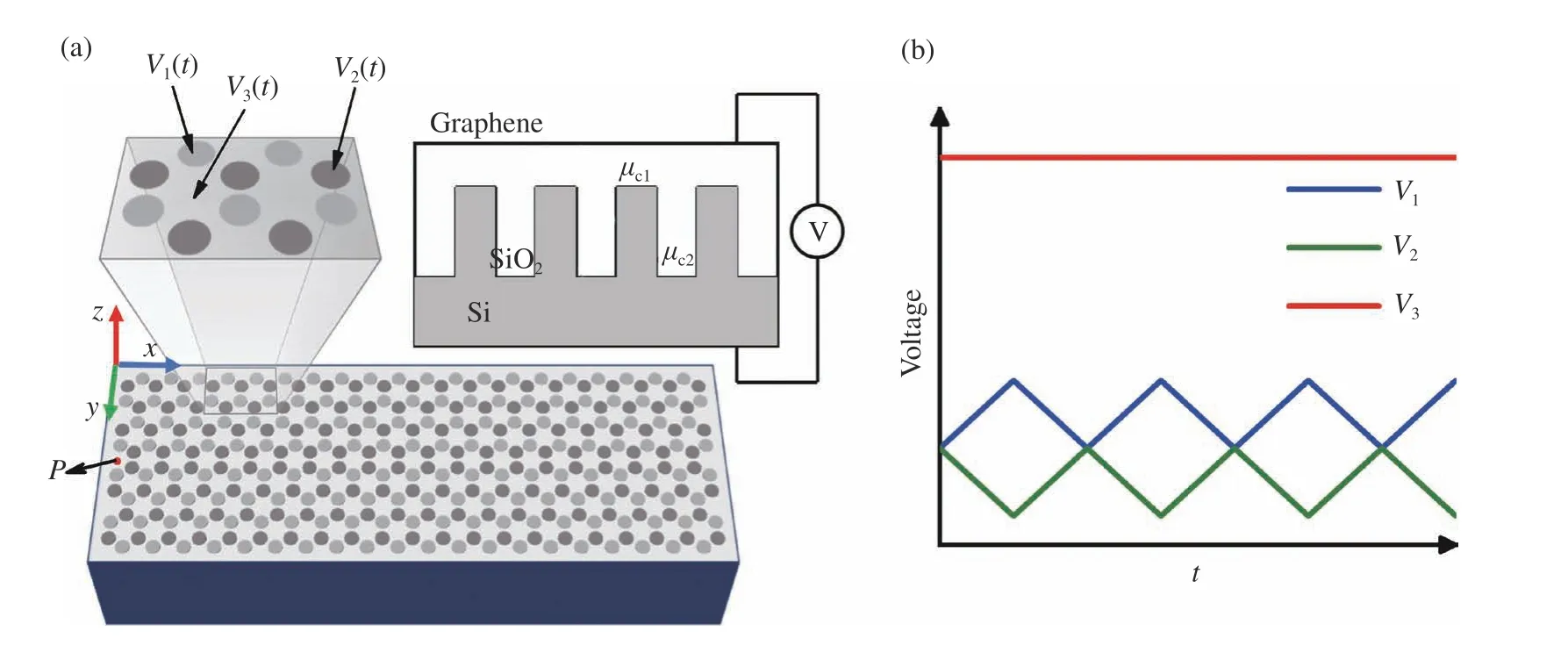
Fig. 1 (a) The three-dimensional schematic of slow light waveguide, with a single layer of graphene nanodisks at the top. The graphene is exposed to air on the top, the background material is SiO2, and the substrate material is Si. Different graphene nanodisks are applied with different bias voltages: V1(t), V2(t) and V3(t). The diagram on the right shows how voltage is applied. (b) The graphene nanodisk’s external bias voltage changes periodically with time图1 (a) 慢光波导的三维示意图,顶部是单层石墨烯纳米盘。石墨烯与空气接触,背景材料是 SiO2,衬底材料是Si。对不同的石墨烯纳米圆盘分别加载不同的偏置电压:V1(t),V2(t)和V3(t),右上图为电压的施加方式。(b) 石墨烯纳米盘外加偏置电压随时间周期性变化的曲线
It is assumed that the relative permittivity of the surrounding environment of graphene is εr1and εr2, respectively. The relative permittivity of the substrate SiO2is εr1=3.9, and the relative permittivity of the air on the upper surface of the graphene is εr2=1. In our numerical simulation, the TM mode is considered and the electric field form of TM mode is assumed to be[21]:
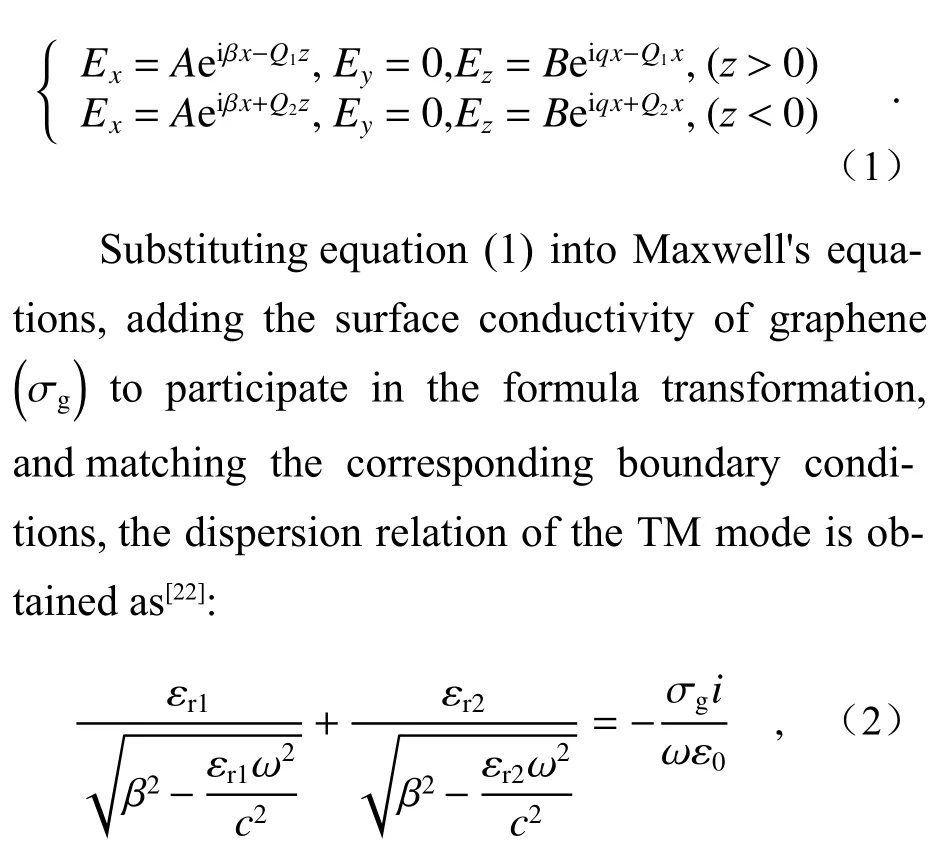
where ε0is the vacuum permittivity in free space,ω is the angular frequency of the plasmon, andcis the propagation speed of light in vacuum. In the whole calculation process, we only consider the case of the propagation constant β≪,so equation (2) can be simplified to the following form[23]:

where β is the propagation constant based on graphene SPP, the surface conductivity of graphene σgcan be adjusted with temperatureT, chemical potential μc, scattering rate τ and angular frequency ω,which consists of two parts: intra-band electron scattering σintraand inter-band electron transition σinter, according to Kubo Formula[23]:

where kBis the Boltzmann constant, e is the charge of the electron, andh¯ is the reduced Planck constant.Specifically, the chemical potential of graphene μccan be effectively tuned by an externally applied voltage[20-21,24-25].

wherevFis the Fermi velocity,Coxis the gate capacitance[26], andVg(t) is the applied voltage that changes periodically with time. In this paper, the curve of the applied bias voltage of graphene nanodisk changing periodically with time is shown in Fig. 1(b) (Color online). By changing the bias voltagesV1(t),V2(t) andV3(t) applied to the graphene nanodisks, the graphene chemical potentials μc1(t), μc2(t) and μc3(t) are changed.
3 Numerical simulation results and discussion
3.1 Graphene plasmonic time crystal model and properties
First, we explored the energy band topology of 2D graphene plasmonic crystals composed of graphene nanodisk arrays arranged in a triangular lattice. The time crystal structure of graphene plasmon is shown in Figure 2 (a). The dotted line area is the crystal cell, and the solid line part is the Brillouin region of the crystal, where Γ-M-K-Γ is the reduced wedge of Brillouin region,ais the crystal lattice constant,a=40 mm, and the radius of graphene nanodisk is expressed asrandr=0.21a.μc1, μc2and μc3are the chemical potentials of different graphene nanodiscs, respectively. From equation (7), it can be seen that the chemical potentials of these graphene nanodiscs can also change periodically with time, which can be written as μc1(t) ,μc2(t) and μc3(t)[27-29]. The chemical potential of graphene nanodisks can be flexibly controlled in time by applying periodic changed bias voltage ofV1(t),V2(t) andV3(t). Here, we calculate the energy bands of graphene plasmonic time crystals at several moments in one cycle, as shown in Fig. 2(b)(Color online), where the black line depicts that,whent=0 s (i.e. Δμc=μc1-μc2=0 eV), the chemical potentials of the graphene nanodisk are μc1= μc2=0.3 eV and μc3=0.6 eV, respectively, the two energy bands degenerate at theKpoint and intersect at the Dirac point, and there is obviously no band gap.During the periodic change of chemical potential with time, the time-translation symmetry of the graphene plasmonic time crystal is broken, the Dirac cone dispersion will be split, and the band gap will be opened[30]. The green, blue and red curves in Fig. 2(b) depict the band structures of the following three time nodes:t1=1 e-12s (i.e.Δμc= 0.1 eV),t2= 1.5 e-12s (i.e. Δμc= 0.12 eV) andt3=2 e-12s (i.e. Δμc=0.14 eV), respectively. It is clear that the crystal band gap undergoes a process from closing to opening over time. It is worth noting here that this graphene plasmonic time crystal energy band change over time can be performed without changing the geometry.

Fig. 2 (a) Schematic diagram of graphene plasmon time crystal structure. (b) Energy band diagrams of graphene plasmon time crystals at four different moments in a cycle of external bias voltage change图2 (a) 石墨烯等离激元时间晶体结构示意图。(b)在一个外加偏置电压变化周期内,石墨烯等离激元时间晶体在4 个不同时刻的能带图
In order to verify the properties of graphene plasmonic time crystals, a numerical simulation study is designed in this work. As shown in Fig. 3(d), in a region composed of graphene plasmonic time crystals, an excitation source is placed at pointP, and the relationship between the chemical potentials of graphene nanodisks satisfies the variation law shown in Fig. 3 (a). Here, electromagnetic waves with a frequency of 46.50 THz are excited from the excitation source. We further explored the change trend of crystal energy band gap with the change of graphene chemical potential. By analyzing the opening and closing of the band gap, the propagation phenomenon occurs when the frequency of the excitation wave is in the conduction band; however, when the frequency is in the band gap, the wave will not propagate in this time interval[31-33]. The simulation results are shown in Figure 3(Color online), in which screenshots are taken of the electric fields at four time nodes during the transmission process. With the periodic change of Δμcin time, the transmission and inhibition alternate phenomenon occurs in the timing oftb=3.20 e-12s,tc= 4.16 e-12s,td= 5.82 e-12s andtf=8.24 e-12s, respectively. This result can well illustrate that the graphene plasmonic time crystal can realize the periodic opening and closing of the energy band gap with time by periodically adjusting the chemical potential.

Fig. 3 (a) When μc3=0.6 eV, the relationship between Δμc and t. (d) A region composed of 5×10 graphene plasmon time crystals. P is the position of the excitation source. (b), (c), (e) and (f) Screenshots of four moments in the propagation process at the time nodes of t b =3.20 e-12 s, t c= 4.16 e-12 s, t d =5.82 e-12 s and t f=8.24 e-12 s, respectively图3 (a) 当 μc3= 0.6 eV 时, Δμc与t 的关系。(d) 5×10 石墨烯等离激元时间晶体组成的一个区域,P 是激发源的位置。(b),(c),(e)和(f)是传播过程中4 个时刻的截图,时间节点分别是 t b =3.20 e-12 s, t c= 4.16 e-12 s, t d =5.82 e-12 s 和t f=8.24 e-12 s
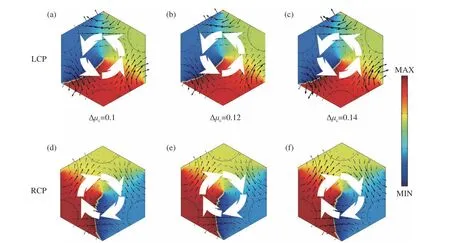
Fig. 4 The phase distributions of Left-handed Circularly Polarized (LCP) and Right-handed Circularly Polarized (RCP) of the time crystal appear at point K, which are expressed as the component of the electric field in the direction Z and the inplane Poynting vector (Px, Py). (a) and (d) the phase distribution diagram of point K at the time of Δμc=0.1 eV; (b) and(e) the phase distribution diagram of point K at the time of Δμc=0.12 eV; (c) and (f) the phase distribution diagram of point K at the time Δ μc=0.14 eV图4 时间晶体在K 点分别出现了左旋圆极化(LCP)和右旋圆极化(RCP)的相位分布,表示为电场在Z 方向上的分量和面内坡印亭矢量(Px, Py)。(a)和(d)是在 Δμc= 0.1 eV 时刻,K 点的相位分布图;(b)和(e)是在 Δμc=0.12 eV 时刻,K 点的相位分布图;(c)和(f)在 Δμc=0.14 eV 时刻,K 点的相位分布图

Fig. 5 (a) Schematic diagram of the Zigzag interface based on graphene plasmon time crystals, in which the bottom is the calculation model of the finite period super cell unit and the simulation electric field distribution results. (b) The dispersion curves of the Zigzag interface mode at different times图5 (a) 基于石墨烯等离激元时间晶体构成的Zigzag 边界示意图。其中,底部分别是有限周期超胞单元的计算模型和仿真电场分布结果。(b)不同时刻下Zigzag 边界模的色散曲线
3.2 Zigzag topological boundary structure theory and model
When the time-translational symmetry of the graphene plasmonic time crystal is broken, the Dirac cone dispersion is not preserved. From the point of view of group theory, when the inversion symmetry is broken, the group symmetry of the point (KorK′) will be reduced fromC3vtoC3. In the energy band, the Dirac cone is destroyed, and the two energy bands originally degenerated to the pointKwill be opened[34-35]. By analyzing the change of the orbital angular momentum at the valley of the energy band after the energy band is opened, we obtain the phase distribution at pointKat time oft1=1 e-12s (i.e.Δμc= 0.1 eV),t2= 1.5 e-12s (i.e. Δμc= 0.12 eV) andt3=2 e-12s (i.e. Δμc=0.14 eV). As shown in Figure 4(Color online), it can be seen that, at different times,the two energy bands appear the phase distribution of Left-handed Circular Polarization (LCP) and Right-handed Circular Polarization (RCP) at the degenerate pointK, respectively, that is, in the process of Δ μcchanging with time, the energy valley at any moment has the circularly polarized orbital angular momentum in the opposite direction after the time crystal energy band is opened. Therefore, we construct electromagnetic transport at the topological edge through electromagnetic modes that can be loaded with different orbital angular momentums,which provides a theoretical basis for the use of topological boundary to construct slow light waveguides.
In this study, Zigzag topological boundaries are used to construct slow light waveguides. This topology is constructed from graphene plasmonic time crystals, which generate “ temporal topological boundary states”, they are temporal analogs of topological edge states[13]. Breaking the time-translational symmetry of graphene plasmonic time crystals will lead to the opening of Dirac points at band degeneracy, thus forming a full band gap in which topologically protected boundary modes exist. The red dotted line in Figure 5(a) (Color online) is the Zigzag topology interface. By sampling the area within the black dotted line, a finite period (N=19) supercell model is established in the commercial simulation software COMSOL Multiphysics. Part of the simulation results are shown at the bottom of Fig. 5(a) (Color online), and it can be seen that the electric field distribution is concentrated at the boundary. We also calculated the dispersion relation of this boundary mode at different times(Fig. 5(b)), and the gray area represents the projected body energy band diagram. Fig. 5(b) also depicts the projected energy bands of three boundary states at the timet1= 1 e-12s,t2=1.5 e-12s andt3= 2 e-12s[36]. Obviously, when Δμcchanges with time, there is always a corresponding boundary state at each moment, which means that the time simulation based on the Zigzag topology boundary state of the graphene plasmon time crystal is realized.
3.3 Slow light phenomenon and field enhancement effects
By further analyzing the dispersion relation of the above boundary modes, we can deduce a phenomenon that the group velocity is zero (slow light)at the extreme point of the dispersion curve. In order to better study the group velocity of guided modes existing in this boundary state, the partial dispersion curves at three different times are plotted in Fig. 6(a) (Color online). It is obvious that the dispersion is accompanied by severe bending, which leads to the existence of slow light mode in the gap.Based on the dispersion curves of these boundary modes, the change curve of the group velocity with angular frequencywcan be calculated with the relationshipvg=dω/dk[37-38]. As shown in Figure 6(b)(Color online), the red curve is the group velocity att1= 1 e-12s and Δμc=0.1 eV, the group velocity tends to zero, and the frequency to 50.237 0 THz. Att2= 1.5 e-12s and Δμc=0.12 eV, the electromagnetic wave group velocity is close to zero at the frequency of 50.114 9 THz, which is depicted in Fig. 6(b) by the blue curve. Att3=2 e-12s and Δμc=0.14 eV, the group velocity is close to zero at a frequency of 49.929 2 THz, which is marked by the green curve. Numerical calculation results show that the group velocity of electromagnetic waves with different frequencies reach zero at different moments, that is, the topological boundary can realize slow light that its certain frequency electromagnetic wave group velocity near zero at different moments.
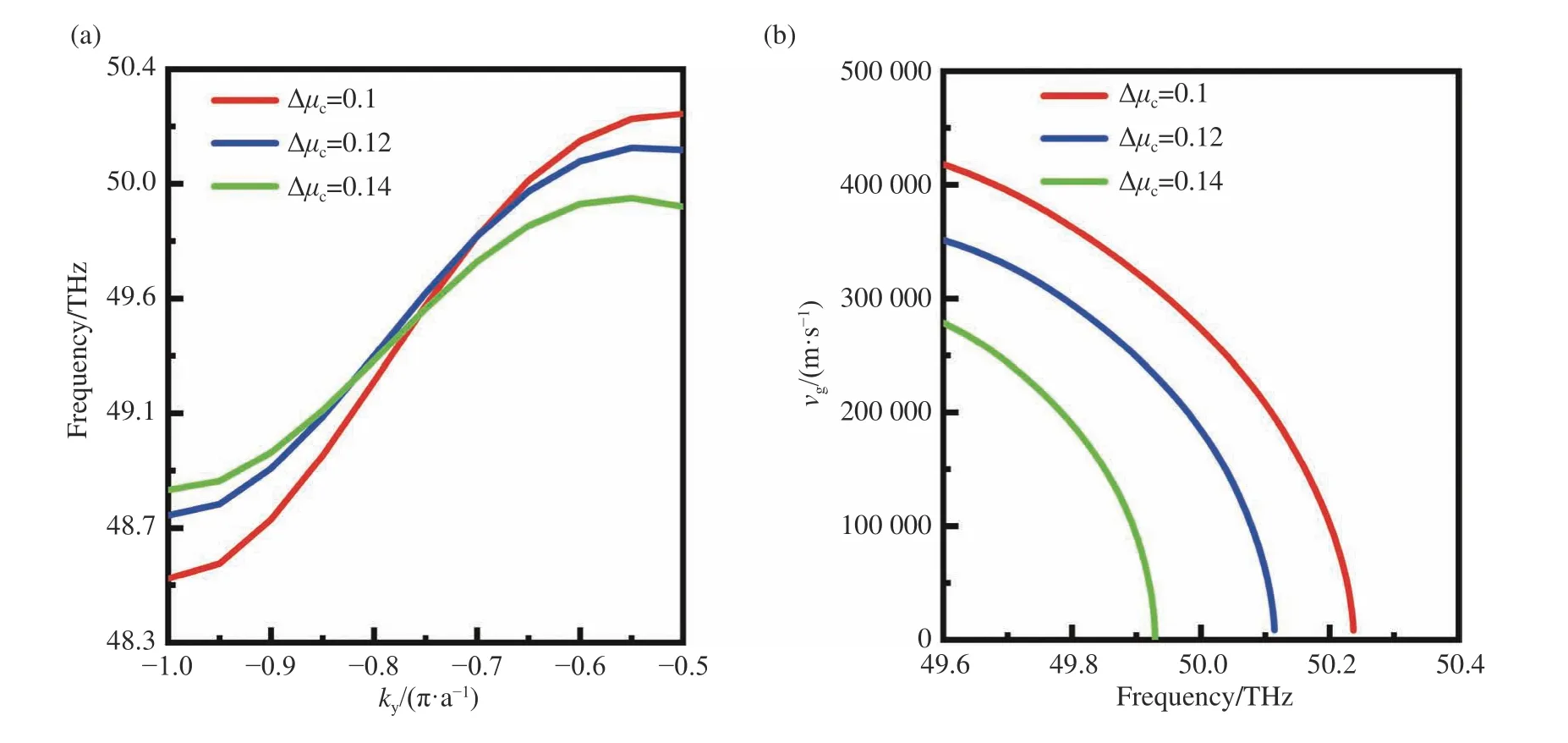
Fig. 6 (a) The boundary mode dispersion curve supported by the topological boundary under different Δμc. (b) The relationship between group velocity and frequency under different Δμc图6 (a) 不同 Δμc下 拓扑边界所支持的边界模色散曲线。(b)不同 Δμc下群速度随频率的变化关系图
Finally, with the slow light waveguide model given in Fig. 1(a), a two-dimensional modeling is carried out in the simulation software COMSOL, the Zigzag boundary structure is used as the transmission channel, and the excitation source is located atP(as shown in Fig. 1(a)). The chemical potential of graphene nanodisks can be flexibly controlled in time by applying a bias voltage that varies periodically withV1(t),V2(t), andV3(t). The graphene SPP wave with a certain frequency is emitted from pointP, and the whole process of its transmission in the waveguide over time can be obtained. Figure 7(Color online) shows the electric field intensity distribution results of plane waves with frequencies of 50.237 0 THz, 50.114 7 THz and 49.929 2 THz propagating in the waveguide respectively. In this simulation, the plane wave with a frequency of 50.237 0 THz is continuously excited from pointPatt0=0 s , and reaches a state where the group velocity is close to zero after traveling along the waveguide for time 1 e-12s, and the SPP wave transmission stagnates at the position ofX=307.998 nm.Figure 7(a) shows the electric field screenshot of a plane wave with a frequency of 50.237 0 THz at timet1=1 e-12s during the transmission process. After the plane wave group velocity is close to zero, the excitation in the slow light mode is continued, and it is found that the electric field intensity at the position ofX=307.998 nm (the green dot in Fig. 7(a))reaches the maximum value att=1.4 e-12s, and the electric field intensity at this time is much greater than that at the excitation source. Plotting the electric field intensity in the waveguide att=1.4 e-12s in Fig. 7 (b), it can be found that the field intensityBat the light energy capture point is greater than the field intensityAat the excitation source. By plotting the change process of the electric field intensity at the green dot position in the time period fromt0=0 s tot=1.4 e-12s is depicted in Fig. 7(c), we can see that the waveguide achieves a continuous superposition of the electric field strength at the light energy trapping point (green dot) and is higher than the enhancement effect of the excitation source due to the field enhancement effect in slow light transmission[4]. Figure 7(d) shows the electric field distribution of the SPP wave with a frequency of 50.114 7 THz from pointP, which is continuously excited from timet0=0 s, and propagates along the waveguide for time 1.5 e-12s. When SPPs wave is transmitted tot2=1.5 e-12s, the group velocity atX=667.879 nm decreases to zero. In addition, we also continuously observed the electric field at the light energy capture pointX=667.879 nm (blue dot in Fig. 7 (d)), and obtained the cross-section of the electric field distribution at the boundary att=2.98 e-12s, as shown in Fig. 7 (e). This result shows that at timet=2.98 e-12s, the electric field intensity at the light energy capture point reaches the maximumDand is greater than the electric field intensityCat pointP. Figure 7(f) depicts the superposition process of the electric field strength at the blue dot from timet0=0 s tot=2.98 e-12s. Similarly, as shown in Fig. 7(g), the SPP wave with a frequency of 49.929 2 THz is continuously excited from pointPat timet0=0 s, and reaches a near-zero group velocity after traveling along the waveguide for 2 e-12s. The light energy trapping is located atX=1 029.122 nm(red dot in Fig. 7(g)). Continuous excitation is carried out in the slow light mode, and it is observed that the electric field at the light energy capture place reaches the maximum intensityFat timet=3.22 e-12s, which is much greater than the electric field intensityEat the excitation source, as shown in Figure 7(j). During the time period fromt0=0 s tot=3.22 e-12s, the change process of the electric field intensity at the position of the red dot is depicted in Fig. 7(j), which also experienced a process of superposition of the electric field intensity. The above simulation process takes SPP waves with three different frequencies, and modulates the light group velocity close to zero by changing the applied bias voltage on the graphene nanodisk respectively. It can be seen that under the influence of the field enhancement effect, the waveguide realizes the continuous superposition of electric field intensity at the light energy capture point, which is higher than that at the excitation source. These results show that the slow light waveguide can make the SPP waves with different frequencies stop at different times and positions, and the field enhancement effect occurs at the corresponding optical energy capture points. In this work, graphene plasmonic time crystals are used to construct transmission waveguides, realizing the modulation of slow light group velocity simply by tuning the chemical potential of graphene. Compared with traditional waveguides such as photonic crystal line defect waveguides[19], its structure is simpler. Even if the structure is fixed, the waveguide performance can be flexibly modulated by changing the applied voltage, which greatly improves the electrical tunability of slow light waveguides. In addition, the SPP wave propagates at the topological boundary as an evanescent wave whose electric field amplitude is continuously attenuated,and the longer the transmission distance, the stronger the attenuation. By applying continuous excitation at the excitation source and recording the field strength superposition process at the optical energy capture point of the waveguide, we intuitively show the electric field change caused by the field strength superposition effect in time, which is not found in the previous slow light research work[11]. Since the modes in the waveguide are not discrete, degeneracy of the forward and backward modes will occur, resulting in energy loss. Therefore, when the optical group velocity is zero in the time sequence, the phenomenon of completely stopping the optical group velocity, the so-called "stationary rainbow", does not actually occur.
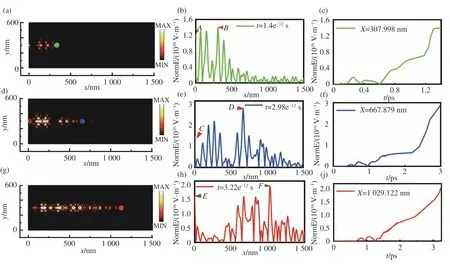
Fig. 7 (a, d, g) Screenshots of the electric field intensity distribution at t1, t2 and t3. (b, e, h) Cross-sectional electric field diagrams at the Zigzag boundary at different time t. (c, f, j) The changing process of the electric field at the capture point of light energy图7 (a, d, g) t1,t2 和t3 时刻电场强度分布截图。(b, e, h) 不同t 时刻Zigzag 边界处截面电场图。(c, f, j) 光能捕获点处电场变化过程
4 Conclusion
In this paper, the time crystal band gap is periodically opened and closed by dynamically controlling the periodic change of the external voltage of the graphene nanodisk with time. Slow light transmission with the group velocity near zero is realized by the slow light waveguide made of graphene plasmon time crystal. The simulation results show that when the light propagates in the waveguide, a group velocity close to zero can be obtained, which is accompanied by the appearance of the field enhancement effect at the corresponding optical energy trapping point of the waveguide. In the case of adjusting the external bias voltage, the operating frequency of the slow optical waveguide can be effectively adjusted. Our research will be applied in the future to devices in the fields of on-chip light buffering and enhanced light-matter interactions.
——中文对照版——
1 引 言
慢光技术在光场调控及光存储器件中的潜在应用前景颇为广阔[1-3],因而备受关注。通过控制结构色散来实现慢光是目前常用的技术之一,该技术的主要方法是通过设计特定结构的慢光波导实现对光群速度的控制。已经在多个研究中观察到这类光子晶体波导中产生的慢光[4-5]。然而,在以往的慢光波导结构中,当群速度变慢,其支持的带宽将变得非常狭窄,同时还伴随着巨大的群速度色散效应。Scheuer J 等人采用结构复杂的耦合谐振光波导实现内部色散补偿,解决了失真问题[6]。近年来,人们采用表面等离激元极化子(Surface Plasmon Polaritons, SPPs)波导来实现慢光,在结构固定的情况下可以获得更高的慢光容量,但慢光性能的调整受到限制[7]。同样地,啁啾结构所具有的极大的群速度色散效应会使光信号严重失真,并且器件的工作频率范围有限[8]。再者,传统的慢光器件的结构设计复杂且结构一旦固定其可调谐性能就很差,从而限制了它们的实际应用。
光子晶体拥有良好的拓扑能带效应,其拓扑概念在光子学领域的应用中极具潜力,从而引起了人们的广泛关注。拓扑光子结构已经颠覆了一些关于波传播和操控的传统观点。将拓扑光子晶体应用于波的传播,可以实现如无反射的急剧弯曲的波、鲁棒的延迟线、自旋极化开关和非互易器件[9],使新型的光子器件成为可能。最近,陈晓东等人提出并证明了拓扑光子晶体中的谷态可以作为拓扑保护来实现光的传输,该设计是将两个拓扑结构不同的拓扑光子晶体镜像放置构成可以实现拓扑保护的界面[10]。之后, Yoshimi 等研究人员提出了一种在谷态光子晶体中实现拓扑慢光波导的结构[11]。该波导结构是基于半导体基底,实现拓扑带隙范围内群指数大于100 的慢光传输,但制作工艺较为复杂,不具备可调谐性,同时没有涉及慢光所带来的场强变化。随着研究的深入,发现在折射率随时间周期性变化的光子时间晶体材料中可以实现谷态这种拓扑带隙结构[12]。方法是通过打破晶体时间平移对称,光子时间晶体可以实现拓扑非平庸相位[13-15],从而影响光在晶体中的传播。
众所周知,石墨烯具有独特的电学和光学特性,尤其是其支持表面等离子激元波,具有相对较低的欧姆损耗及较强的可调谐性等优点[16]。Jin 等人设计了具有周期性图案的单层石墨烯,通过引入静态磁场实现了拓扑单向边界传输[17]。之后,王洋等学者实现了用于传感应用的双层石墨烯超表面中的拓扑谷等离子体传输[18]。最近,郭翔等研究人员通过光子晶体线缺陷设计了石墨烯SPP 等效二维光子晶体慢光波导,通过石墨烯在空间上的化学势渐变来实现慢光的调制[19]。同样地,在时间上实现对石墨烯等离激元晶体谷态拓扑慢光传输的调制是非常有意义的工作。本文提出了一种在石墨烯等离激元时间晶体构造的波导中实现拓扑慢光传输的新方法。二维石墨烯等离激元时间晶体由一组呈蜂窝状周期性排列的石墨烯纳米盘组成。通过控制石墨烯的化学势随时间周期性变化,打破了石墨烯等离激元时间晶体的时间平移对称性。数值仿真表明,等离激元时间晶体能带带隙可以随时间周期性地打开和闭合。进一步研究发现:锯齿形边可以支持在拓扑带隙内实现接近零的电磁传输群速度。对慢光波导电磁传输进行数值仿真,模拟结果表明该拓扑波导能够产生慢光。该方法的优点是结构简单,具有较好的场增强效果和动态调谐能力,为动态实现光场调控提供了新的途径和方法。
2 数值仿真方法和模型
本文基于石墨烯等离激元时间晶体实现谷态拓扑慢光传输波导。如图1(a)(彩图见期刊电子版)所示,该波导采用Zigzag 结构拓扑界面作为传输通道,顶部由石墨烯纳米盘构成。石墨烯与空气接触,背景材料选择的是SiO2,衬底材料是Si。从图中的波导截面图可以看出,偏置电压加在石墨烯纳米盘与硅衬底上。其中硅柱按三角晶格排列,V1(t),V2(t) 和V3(t) 分别是外加在石墨烯纳米盘上的偏置电压,这种方式是基于石墨烯等离激元的光子晶体机理实现的[20]。当石墨烯与衬底之间的距离一定时,通过改变外加电压就可以改变石墨烯的化学势。
假设石墨烯周围环境的相对介电常数分别为 εr1和 εr2。其 中,衬底采 用相对 介电常数 为εr1=3.9 的SiO2,石墨烯上表面空气的相对介电常数为 εr2=1。在该模型中,数值仿真考虑TM 模式,假设该TM 模式的电场形式为[21]:

将式(1)代入麦克斯韦方程组,通过添加石墨烯的表面电导率 (σg)参与公式变换,并匹配相应的边界条件,得到TM 模式的色散关系[22]:

其中 ε0为自由空间中的真空介电常数, ω为等离激元的角频率,c为光在真空的传播速度。在整个计算过程中,只考虑传播常数 β ≪的情况,因此方程(2)简化为以下形式[23]:
其中 β是基于石墨烯SPP 的传播常数,石墨烯的表面电导率 σg可随温度T、化学势 μc,散射速率τ和 角频率 ω进 行调节,其由带内电子散射σintra和带间电子跃迁 σinter两个部分组成,根据Kubo公式[23]:

其中 kB是 玻尔兹曼常数, e 是 电子的电荷,h¯是约化普朗克常数。具体来说,石墨烯的化学势 μc可以通过外部外加电压有效地调节[20-21,24-25]。

式中vF为费米速度,Cox为栅电容[26],Vg(t)为随时间周期性变化的外加电压。石墨烯纳米盘外加偏置电压随时间周期性变化的曲线,如图1(b)(彩图见期刊电子版)所示。通过改变外加在石墨烯纳米盘上的偏置电压V1(t),V2(t) 和V3(t),可以改变石墨烯化学势μc1(t), μc2(t)和 μc3(t)。
3 数值仿真结果与讨论
3.1 石墨烯等离激元时间晶体模型及性能
首先,探究了由排列成三角晶格的石墨烯纳米盘阵列组成的二维石墨烯等离激元晶体能带拓扑结构。如图2(a)所示,石墨烯等离激元时间晶体结构,虚线区域为晶体元胞,实线部分为晶体的布里渊区,其中 Γ-M-K-Γ为简约布里渊区,a 是晶体晶格常数,石墨烯纳米盘半径表示为r。μc1, μc2和 μc3分别是不同石墨烯纳米盘的化学势,由式(7)可知,这些石墨烯纳米盘的化学势也是可以随时间作周期性变化的,固可以写成 μc1(t),μc2(t)和 μc3(t)[27-29]。通过对石墨烯纳米盘的外加偏置电压加以V1(t),V2(t)和V3(t)的周期变化,可以在时间上灵活地控制其化学势。在这里,计算了一个周期内若干时刻石墨烯等离激元时间晶体的能带,如图2(b)(彩图见期刊电子版)所示。其中,黑线描绘的是当t=0 s (即 Δμc=μc1-μc2=0 eV)时,石墨烯纳米盘的化学势分别为 μc1= μc2=0.3 eV 和μc3=0.6 eV,两条能带在K点处简并相交于狄拉克点,且明显不存在带隙。在化学势随时间周期性变化的过程中,石墨烯等离激元时间晶体的时间平移对称性被打破,狄拉克锥色散将被分裂,带隙将会打开[30]。图2(b)中的绿色、蓝色和红色曲线分别描绘了如下3 个时间节点的能带结构:t1=1 e-12s (即 Δμc= 0.1 eV),t2= 1.5 e-12s (即 Δμc=0.12 eV)和t3= 2 e-12s (即 Δμc=0.14 eV)。很明显,晶体能带带隙随着时间的推移会经历一个从闭合到打开的过程。在这里值得注意的是,这种石墨烯等离激元时间晶体能带随时间的变化是可以在不改变几何结构的情况下进行的。
为了验证石墨烯等离激元时间晶体所具有的特性,本项工作设计了数值仿真实验。如图3(d)所示,在一片由石墨烯等离激元时间晶体构成的区域中,将一激励源放置在P 点处,石墨烯纳米盘的化学势之间的关系 Δμc满足图3(a)中的变化规律。在这里,从激发源中激发出频率为46.50 THz的电磁波。进一步探究在石墨烯化学势变化的同时,时间晶体能带带隙的变化趋势。通过分析带隙的打开及关闭,当激发波的频率位于导带时,传播现象发生;可当这个频率处在带隙内时,波就不会在这个时间间隔内传播[31-33]。仿真结果如图3(彩图见期刊电子版) 所示,对传输过程中4 个时间节点的电场进行截图。随着 Δμc在时间上作周期性变化,分别在tb= 3.20 e-12s,tc=4.16 e-12s,td=5.82 e-12s和tf=8.24 e-12s 的时序中出现传输和禁止交替现象。而这个结果可以很好地说明,石墨烯等离激元时间晶体通过对化学势进行周期性调控,可以实现能带带隙随时间周期性的打开和关闭。
3.2 Zigzag 拓扑边界结构理论与模型
当石墨烯等离激元时间晶体的时间平移对称性被破坏时,狄拉克锥色散就不会受到保护。从群论的角度来看,当反转对称被打破时(K或K′)点的群对称性会由C3v降为C3。在能带上的表现为狄拉克锥遭到破坏,原本简并于K点的两条能带将被打开[34-35]。能带打开之后,有关能带能谷处的轨道角动量出现变化,通过分析得到 了 在t1= 1 e-12s (即 Δμc= 0.1 eV),t2=1.5 e-12s (即Δμc= 0.12 eV)和t3= 2 e-12s (即 Δμc=0.14 eV)时刻K点的相位分布。如图4(彩图见期刊电子版)所示,可以看到在不同时刻两条能带简并在K点分别出现了左旋圆极化(Left-handed Circular Polarized, LCP)和右旋圆极化(Right-handed Circular Polarized, RCP)的相位分布。也就是说,在 Δμc随着时间变化的过程中,时间晶体能带打开后任何时刻下的能谷都拥有方向相反的圆极化轨道角动量。因此,可以通过加载不同轨道角动量的电磁模来构成拓扑边缘的电磁传输,这为利用拓扑边界构造来构建慢光波导提供了理论基础。
研究中采用Zigzag 拓扑边界来构建慢光波导。这种拓扑结构是由石墨烯等离激元时间晶体构建的,它产生了“时间拓扑边界态”,是拓扑边缘态的时间模拟[13]。打破石墨烯等离激元时间晶体的时间平移对称性会导致能带简并处的狄拉克点被打开,从而形成一个完整的带隙,其中存在拓扑保护边界模式。图5(a)(彩图见期刊电子版)中红色虚线所在处为Zigzag 拓扑界面,通过对黑色虚线内区域采样,在商用仿真软件COMSOL Multiphysics 中,建立有限周期(N=19) 的超胞单元模型。部分仿真结果如图5(a)的底部所示,可以看出电场分布集中于边界处。本文还计算了不同 Δμc时刻下该边界模的色散关系(图5(b)(彩图见期刊电子版)),灰色区域表示投影的体能带图。图5(b) 还描绘处出了t1= 1 e-12s,t2=1.5 e-12s和t3= 2 e-12s 3 个不同 Δμc时刻下的边界态的投影能带[36]。很显然,当 Δμc随时间变化时,在每个时刻上总有与之相应的边界态存在,这就意味着实现了基于石墨烯等离激元时间晶体Zigzag 拓扑边界态的时间模拟。
3.3 慢光现象和场增强效应
进一步分析上述边界模的色散关系,可以推出在色散曲线的极值点存在群速度为零(慢光)的现象。为了更好地研究存在于该边界态中导模的群速度,将3 个不同时刻的部分色散曲线绘制于图6(a)(彩图见期刊电子版)中,很明显,伴随着严重弯曲的色散,因此导致间隙内慢光模式的存在。根据这些边界模的色散曲线,由角频率 ω与群速度vg关 系满足vg=dω/dk[37-38],可以计算出群速度随频率的变化曲线。如图6(b)(彩图见期刊电子版) 所示,红色曲线是在t1= 1 e-12s 时刻 Δμc=0.1 eV 时的群速度,群速度趋近于零,频率趋于50.237 0 THz。当在t2= 1.5 e-12s 时刻, Δμc=0.12 eV时,电磁波群速度在50.114 9 THz频率处接近于零,以蓝色曲线描绘在图6(b)中。而在t3=2 e-12s时刻 Δμc=0.14 eV 时,在频率为49.929 2 THz,群速度接近零,由绿色曲线标出。数值计算结果表明,不同频率的电磁波会在不同时间达到零群速度。也就是说,该拓扑边界可以实现在不同时刻支持某一频率电磁波群速度接近零的慢光。
最后,根据图1(a)中所给出的慢光波导模型,在仿真软件COMSOL 中对其进行二维建模,设计采用Zigzag 边界结构作为传输通道,激励源位于P处(如图1(a) 所示)。对石墨烯纳米盘的外加偏置电压加以V1(t),V2(t) 和V3(t) 的周期变化,可以在时间上灵活地控制其化学势。将一定频率的石墨烯SPP 波由P点处发出,可以得到其在波导中随时间传输的整个过程。图7(彩图见期刊电子版)给出的是频率分别为50.237 0 THz、50.114 7 THz 和49.929 2 THz的平面波在波导中传输的电场强度分布结果。在本次模拟仿真中,取频率为50.237 0 THz 的平面波从t0=0 s 时刻由P点处持续性激励,沿波导传输1 e-12s后达到群速度接近零的状态,该SPP波传输停滞在X=307.998 nm 位置处。图7(a)(彩图见期刊电子版)所示是频率为50.237 0 THz 的平面波在t1=1 e-12s 时刻的电场截图。在平面波群速度接近零后继续保持慢光模式下的持续激励,结果发现X=307.998 nm 位置处(图7(a)中绿点)的电场强度在t=1.4 e-12s 时刻达到了最大值,且此时的电场强度远大于激励源处的电场强度。将t=1.4 e-12s时刻波导中的电场强度描绘在图7(b)中,可以发现此时光能捕获点处的场强B大于激励源处的场强A。将t0=0 s 至t=1.4 e-12s 时间段内在绿点位置处电场强度变化过程描绘在图7(c)中。可以看到,由于慢光传输中的场增强效应,波导在光能捕获点(绿点)处实现了电场强度的持续叠加并高于激励源的增强效果[4]。图7(d)展示了频率为50.114 7 THz 的SPP波从t0=0 s 时刻由P点处持续性激励,沿波导传输时间1 .5 e-12s后的电场分布图。SPPs 波传输来到t2=1.5 e-12s 时刻,在X=667.879 nm 位置处的群速度下降至零。同时还对光能捕获点X=667.879 nm 处(图7(d) 中蓝点) 的电场进行了持续观测,得到t=2.98 e-12s时刻的边界处电场分布截面图,如图7(e) 所示。该结果表明,在t=2.98 e-12s 时刻光能捕获点处的电场强度达到最大值D,并且大于P点处的电场强度C。图7(f)描绘了从时间t0=0 s 到t=2.98 e-12s,蓝点处的电场强度叠加过程。同理,如图7(g) 所示,频率为49.929 2 THz 的SPP 波从t0=0 s 时刻由P点处不断的激励,沿波导传输 2 e-12s后达到接近零的群速度,波导对于该SPP 波传输的光能捕获位于X=1 029.122 nm 处(图7(g)中红点)。在保持慢光模式下进行持续性激励,观测发现光能捕获处的电场在t=3.22 e-12s 时刻到达最大强度F,该电场强度远大于激励源处的电场强度E,如图7(j)所示。从t0=0 s 至t=3.22 e-12s 时间段内在红点位置处电场强度变化过程描绘在图7(j)中,同样经历了一个场强叠加的过程。上述模拟仿真过程取了3 个频率的SPP 波,分别在改变石墨烯纳米盘外加偏置电压将光群速度调制接近零。在场增强效应的影响下,波导在光能捕获点处实现了电场强度持续叠加并高于激励源处的电场强度。这些结果表明,该慢光波导可以实现不同频率的SPP 波在不同的时间和位置处停滞下来,并在相应的光能捕获点处发生场增强效应。在这项工作中使用石墨烯等离激元时间晶体构造传输波导,仅通过调谐石墨烯化学势就可以实现对慢光群速度的调制。其与光子晶体线缺陷波导[19]等传统波导相比,在结构上更为简单,即使结构固定,也可以通过改变外加电压灵活调制波导性能,极大地提高了慢光波导的电可调谐性。此外,SPP 波在该拓扑边界传输表现为电场幅值不断衰减的倏逝波,传输距离愈远衰减愈强。在激励源处施加持续的激励,通过记录波导光能捕获点处的场强叠加过程,在时间上直观地展现了由场强叠加效应所引起的电场变化,是之前对慢光研究工作中所没有的[11]。由于波导中的模式并非是离散的,会发生前后向模式的简并,最终使能量流失。因而在时序中实现光群速度为零时,所谓“静止彩虹”的完全停止光群速度的现象并不会真实发生。
4 结 论
本文通过动态控制石墨烯纳米盘外接电压随时间的周期性变化,使时间晶体的能带带隙周期性地打开和关闭。利用石墨烯等离激元时间晶体制作慢光波导,获得了群速度接近零的慢光传输。仿真结果表明,光在该波导中传播时,可以获得接近零的群速度,并伴随着相应的波导光能捕获点处场增强效应的出现。在调节外部偏置电压的情况下,慢光波导的工作频率可以得到有效的调节。本项研究将在未来应用于片上光缓冲和增强光与物质的相互作用领域的器件中。
